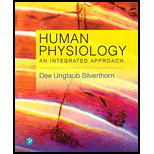
Concept explainers
a.
To determine: The difference between lymphatic and systemic capillaries.
Introduction: The lymphatic system consists of lymphatic organs, lymphatic ducts, nodes, and vessels. The lymphatic organs are divided into two, the primary lymphoid organs and the secondary lymphoid organs. The primary organs serve as the maturation site for lymphocytes while the secondary organs serve as the differentiation site.
b.
To determine: The difference between the role of the sympathetic and parasympathetic nervous system in blood pressure control.
Introduction: Arterial blood pressure is the pressure applied by the flowing blood inside the arteries of the body. The blood pressure is regulated by several factors that can increase or decrease the blood pressure depending upon the requirement of the body.
c.
To determine: The difference between lymph and blood.
Introduction: The lymphatic system consists of lymphatic organs, lymphatic ducts, nodes, and vessels. The cardiovascular system is made of different components. The heart constitutes the primary organs of the system, and the arteries, veins and blood capillaries form the associated structures of the cardiovascular system.
d.
To determine: The difference between continuous and fenestrated capillaries.
Introduction: The cardiovascular system is made of different components. The heart constitutes the primary organs of the system, and the arteries, veins, and blood capillaries form the associated structures of the cardiovascular system. Among the blood vessels, the pulmonary artery, vein, and aorta form the largest and most important vessel system.
e.
To determine: The difference between hydrostatic pressure and colloid osmotic pressure in systemic capillaries.
Introduction: Hypertension is the condition where the blood pressure of the individual in constantly high due to the increased pressure of blood against the arteries supplying blood to the heart. Hypertension can arise due to narrowing of the lumen of the arteries because of fat deposition.
Want to see the full answer?
Check out a sample textbook solution
Chapter 15 Solutions
Pearson eText Human Physiology: An Integrated Approach -- Instant Access (Pearson+)
- students in a science class investiged the conditions under which corn seeds would germinate most successfully. BAsed on the results which of these factors appears most important for successful corn seed germination.arrow_forwardI want to write the given physician orders in the kardex formarrow_forwardAmino Acid Coclow TABle 3' Gly Phe Leu (G) (F) (L) 3- Val (V) Arg (R) Ser (S) Ala (A) Lys (K) CAG G Glu Asp (E) (D) Ser (S) CCCAGUCAGUCAGUCAG 0204 C U A G C Asn (N) G 4 A AGU C GU (5) AC C UGA A G5 C CUGACUGACUGACUGAC Thr (T) Met (M) lle £€ (1) U 4 G Tyr Σε (Y) U Cys (C) C A G Trp (W) 3' U C A Leu בוט His Pro (P) ££ (H) Gin (Q) Arg 흐름 (R) (L) Start Stop 8. Transcription and Translation Practice: (Video 10-1 and 10-2) A. Below is the sense strand of a DNA gene. Using the sense strand, create the antisense DNA strand and label the 5' and 3' ends. B. Use the antisense strand that you create in part A as a template to create the mRNA transcript of the gene and label the 5' and 3' ends. C. Translate the mRNA you produced in part B into the polypeptide sequence making sure to follow all the rules of translation. 5'-AGCATGACTAATAGTTGTTGAGCTGTC-3' (sense strand) 4arrow_forward
- What is the structure and function of Eukaryotic cells, including their organelles? How are Eukaryotic cells different than Prokaryotic cells, in terms of evolution which form of the cell might have came first? How do Eukaryotic cells become malignant (cancerous)?arrow_forwardWhat are the roles of DNA and proteins inside of the cell? What are the building blocks or molecular components of the DNA and proteins? How are proteins produced within the cell? What connection is there between DNA, proteins, and the cell cycle? What is the relationship between DNA, proteins, and Cancer?arrow_forwardWhy cells go through various types of cell division and how eukaryotic cells control cell growth through the cell cycle control system?arrow_forward
 Human Physiology: From Cells to Systems (MindTap ...BiologyISBN:9781285866932Author:Lauralee SherwoodPublisher:Cengage Learning
Human Physiology: From Cells to Systems (MindTap ...BiologyISBN:9781285866932Author:Lauralee SherwoodPublisher:Cengage Learning Medical Terminology for Health Professions, Spira...Health & NutritionISBN:9781305634350Author:Ann Ehrlich, Carol L. Schroeder, Laura Ehrlich, Katrina A. SchroederPublisher:Cengage Learning
Medical Terminology for Health Professions, Spira...Health & NutritionISBN:9781305634350Author:Ann Ehrlich, Carol L. Schroeder, Laura Ehrlich, Katrina A. SchroederPublisher:Cengage Learning Human Biology (MindTap Course List)BiologyISBN:9781305112100Author:Cecie Starr, Beverly McMillanPublisher:Cengage Learning
Human Biology (MindTap Course List)BiologyISBN:9781305112100Author:Cecie Starr, Beverly McMillanPublisher:Cengage Learning Comprehensive Medical Assisting: Administrative a...NursingISBN:9781305964792Author:Wilburta Q. Lindh, Carol D. Tamparo, Barbara M. Dahl, Julie Morris, Cindy CorreaPublisher:Cengage Learning
Comprehensive Medical Assisting: Administrative a...NursingISBN:9781305964792Author:Wilburta Q. Lindh, Carol D. Tamparo, Barbara M. Dahl, Julie Morris, Cindy CorreaPublisher:Cengage Learning Fundamentals of Sectional Anatomy: An Imaging App...BiologyISBN:9781133960867Author:Denise L. LazoPublisher:Cengage Learning
Fundamentals of Sectional Anatomy: An Imaging App...BiologyISBN:9781133960867Author:Denise L. LazoPublisher:Cengage Learning





